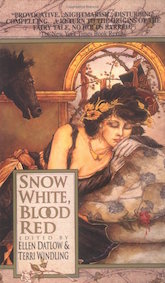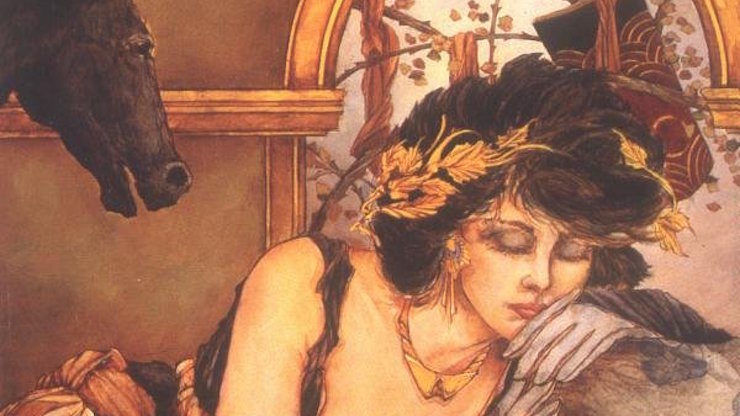In 1993, editors Ellen Datlow and Terri Windling offered up an anthology of fairy tales written expressly for an adult audience, Snow White, Blood Red. Featuring writers as distinct as Neil Gaiman, Jane Yolen, Tanith Lee, Charles de Lint and Patricia McKillip, the anthology contains nineteen fairy tales and one poem, as well as two introductory essays from the editors.
It’s a book that I mostly remembered for one of its retellings of Little Red Riding Hood, and also for introducing me to Charles de Lint’s Newford stories and novels.Rereading it now, I realized that I’d forgotten its other strength: it showcases just how much can be done with and inspired by fairy tales.
Arguably, the introductory essays form the most important part of the anthology, particularly Terri Windling’s lengthy essay outlining the differences between the literary fairy tale—that is, fairy tales carefully crafted for the enjoyment of adults—and the oral fairy tale, along with a discussion of how, slowly, through the late 19th and early 20th century, fairy tales began to be seen as something more for children than for adults—something that, as the essay notes, would have startled many of the writers of literary fairy tales. Windling discusses some of the disturbing moments from some of the original tales, including Sleeping Beauty, and also mentions more modern retellings: the Disney versions (unfavorably) and Angela Carter’s retellings (approvingly.) Ellen Datlow’s shorter, more personal essay discusses her memories of reading fairy tales as a child, and the difficulties of determining what a fairy tale is—something pertinent for this book, which has a few tales that might not, at first glance, seem to be fairy tales.
Let me just note, for the record, that while I can understand Windling’s distaste for Disney’s Snow White and the Seven Dwarfs, I think Windling underestimates the Disney fairy tale films, and just how rich some of those retellings are, and how much some of them—particularly Snow White and the Seven Dwarfs—retain much of the horror of the old fairy tales. Snow White screaming as she faints in the woods and the death of the Evil Queen terrorized generations of kids for a reason. Sleeping Beauty’s small adorable animals are bracketed with images of dancing demons and a fierce dragon. And for all of the emphasis on traditional gender roles in the earlier Disney Princess movies (not really broken until The Princess and the Frog, which was not released until after this collection), the image of three older women joining forces to fight against evil is a deeply subversive image.
 But I’ve talked about that elsewhere. Here, I want to focus more on the tales collected for this volume. As in all anthologies, the quality varies—nothing here is really terrible, but it’s not really surprising that I forgot stories such as Gahan Wilson’s take on “The Frog Prince,” featuring a wet Frog talking to his psychologist, or its immediate successor, Nancy Kress’s “Stalking Beans,” a Jack and the Beanstalk story featuring an adult Jack, and already find myself forgetting them again as I type this now. Other stories, however, are standouts—including a few that I’d forgotten were in here, such as Neil Gaiman’s “Troll Bridge,” kinda about trolls, but more about the difficulties of dealing with life, and Lisa Goldstein’s “Breadcrumbs and Stones,” about Hansel and Gretel, and stories, and memories, and the lies we tell children and ourselves.
But I’ve talked about that elsewhere. Here, I want to focus more on the tales collected for this volume. As in all anthologies, the quality varies—nothing here is really terrible, but it’s not really surprising that I forgot stories such as Gahan Wilson’s take on “The Frog Prince,” featuring a wet Frog talking to his psychologist, or its immediate successor, Nancy Kress’s “Stalking Beans,” a Jack and the Beanstalk story featuring an adult Jack, and already find myself forgetting them again as I type this now. Other stories, however, are standouts—including a few that I’d forgotten were in here, such as Neil Gaiman’s “Troll Bridge,” kinda about trolls, but more about the difficulties of dealing with life, and Lisa Goldstein’s “Breadcrumbs and Stones,” about Hansel and Gretel, and stories, and memories, and the lies we tell children and ourselves.
A few—such as Susan Wade’s “Like a Red, Red, Rose” and Charles de Lint’s “The Moon Is Drowning While I Sleep”—are original fairy tales. (De Lint’s story features various characters from his Newford novels, but you do not need to have read the rest of his work to enjoy this tale.) Most, however, are either retellings of original fairy tales, tooled for adult audiences, or use well known images and motifs from fairy tales to create something new and disturbing, as in Tanith Lee’s “Snow-Drop,” which is only partly a retelling of Snow-White from the evil stepmother’s point of view, and just as much a new story that, with its intelligent house and other factors, has touches of science fiction and surrealism.Also in this vein: Patricia McKillip’s “The Snow Queen,” which transforms Andersen’s tale of death and restoration into a study of marital infidelity and empowerment, and Esther M. Friesner’s “Puss,” which stays relatively close to the plot of Charles Perrault’s “Puss-in-Boots,” but uses the story to introduce an alternative world of shapechangers. (Which does explain the perplexing problem of how that cat was able to talk in the original tale, but I digress.)
The majority of the retellings focus on fairly well known tales such as Snow White and the Pied Piper, though Jack Dann’s “The Glass Casket” is a retelling of one of the more obscure Grimm tales, “The Glass Coffin,” and Steve Rasnic Tem takes on one of Charles Perrault’s comparatively obscure tale of “Little Poucet”—a variation on the tales of Tom Thumb. A few tales dip into the same sources—I counted two Rapunzels and two Little Red Riding Hoods, for instance. In the case of the Rapunzel tales, the contrasting retellings work well, showing that Rapunzel can be told either as a study of abuse and entrapment—as in Gregory Frost’s “The Root of the Matter,” which tells the story through the differing voices of the witch, Rapunzel, and the prince—or played for comedy and empowerment, as in Elizabeth A. Lynn’s “The Princess in the Tower.”
It works rather less well with the Little Red Riding Hood tales. The first, Wendy Wheeler’s “Little Red,” set in more or less the present day, presents the wolf as a sexual predator. A charming man who continues to remind himself and us that yes, yes, he is a man of culture, who has had many women, and who initially targets Little Red’s mother, he sees the young Little Red—only 14—as a sexual object. Worse, Little Red’s mother brags about how many more age-appropriate boys are already chasing after her daughter—bolstering his impression that yes, 14 or not, Little Red is flirting with him.
That element makes the story, told from his viewpoint, is one of the more disturbing and memorable in the anthology (indeed, it was the only one that I clearly remembered, years later)—something which does the next story in the collection, Kathe Koja’s “I Shall Do You Mischief In the Woods,” no favors. (I found I had completely forgotten this story, years later.) Kathe Koja also presents the wolf as sexual predator, but her retelling, a more classic horror tale, loses something by directly following “Little Red.”
Many of the retellings, like “Breadcrumbs and Stones,” are set firmly in the 20th century —or in the case of “Snow-Drop,” a not so far off future, with settings as varied as a baseball game, an Italian restaurant, and a bridge haunted by a troll. Others—including “The Glass Casket,” are set in specific historical times, such as Renaissance Italy, or in a vague period of “long ago.”It all serves to show, as noted, just how much can be done with fairy tales—even if the final quality of the stories tends to be somewhat uneven.
One warning: many of these stories have decidedly unhappy or at best emotionally ambiguous endings. Indeed, I think only two stories here can be said to have happy endings—the two comedic stories, not coincidentally.That was hardly unknown in the old literary fairy tales—about a third of Madame d’Aulnoy’s stories end tragically, for instance, and Hans Christian Andersen virtually perfected bittersweet or ironic endings.Still, tales written for children tended to have happier endings, and the unhappy endings of these tales were written for adults. I bring this up largely because I can’t help noticing the frequent connection between “adult” stories and “unhappy endings.” Children know and understand sorrow too, and adults can know and understand happiness. A different sort of sorrow, a different sort of happiness, true, but still.
Snow White, Blood Red was nominated for a World Fantasy Award, and launched a series of similar anthologies, some of which we’ll be looking at in future posts. But for whatever reason, it now seems to be out of print.A few copies might linger around libraries and used bookstores, however, and—despite those unhappy endings—might well be worth your search.
Mari Ness lives in central Florida.










